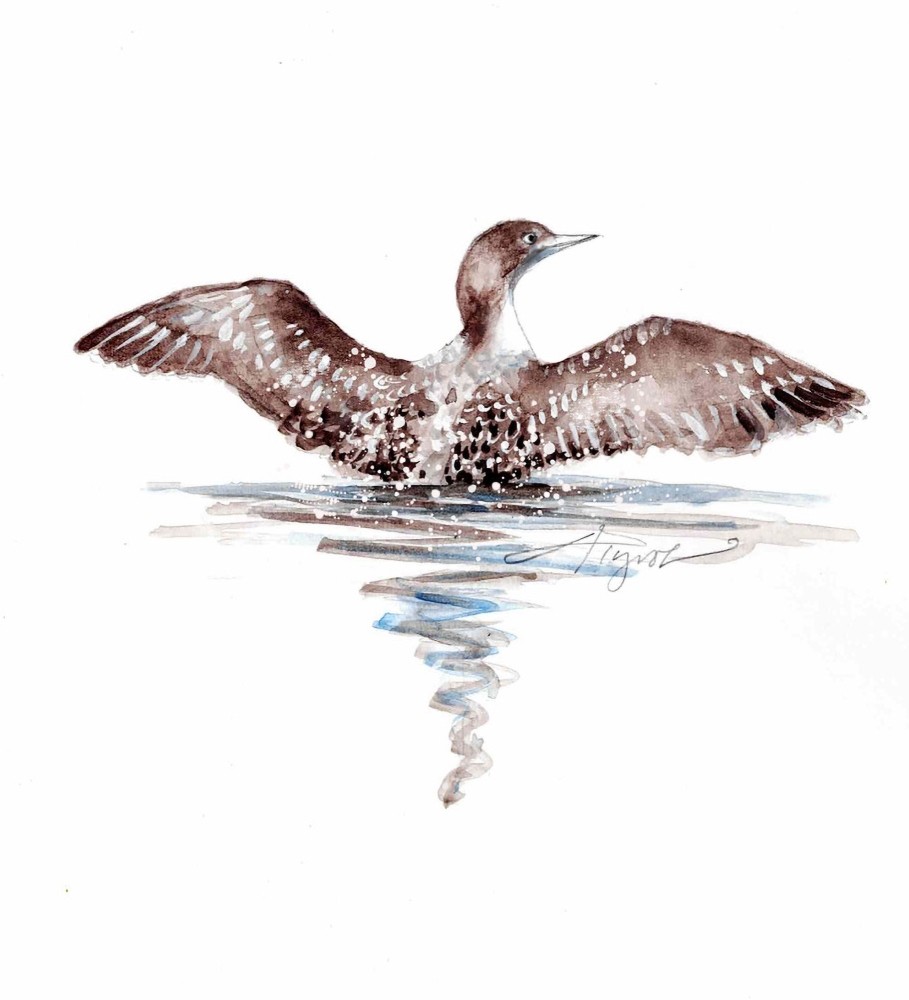
At this point in the season, most migrating songbirds and raptors have already left. But on lakes and ponds across New England, some loons are still fishing and paddling. Loon parents may set off for the ocean before their young can fly, so it’s not uncommon to see loon chicks alone on the water in late autumn.
Concerned birdwatchers sometimes call up Eric Hanson, loon biologist at Vermont Center for Ecostudies, to report what they believe are abandoned loon chicks when they come across young birds without an adult. Hanson, who leads the center’s loon conservation project, assures callers that loon chicks are fairly self-sufficient by 10 weeks of age – sometimes even by 7 weeks – with fully grown feet and effective fishing skills.
Loon chicks spend much of the fall season mastering flight. A common training exercise is “wing rowing” across the water, using their wings like oars to propel themselves forward. To take flight from the water, loons must vigorously flap their wings for as long as a quarter of a mile before they can lift off; substantial wing and chest muscles are imperative for flight. “They have to exercise those for a while before they’re strong enough to get airborne,” Hanson said.
Loons take to the ocean in autumn before their home lakes and ponds freeze, since this prevents them from taking flight, limits their fishing range, and makes them vulnerable to predators. Despite their need to practice flying before migration, some loon chicks have been known to leave their home lakes in early September, while others linger late into the fall. So what explains this broad range in departure times?
Loon behavior is highly varied, biologists say. Lee Attix, a consulting loon biologist who works with volunteers to monitor loon populations, studied fall migration timing from 2013 to 2017, observing 32 loon pairs with chicks across Maine and New Hampshire. (Reproducing loons typically have one or two chicks.) Attix was surprised at how inconsistent migration timing proved to be. During the study’s first two years, departure dates for each pair’s last chick ranged from September 19 to November 20, with October 30 as the average departure date. On average, the first adult departed on October 10, while the second adult left on October 27.
Sometimes when loon chicks first leave their natal lakes, they congregate with other chicks on larger lakes before completing their journey. But Hanson said scientists understand little about how and why a loon chooses its migration route.
Leaving its home waters is only the first step in a loon chick’s inaugural migration. Though short compared to other birds’ – often just one or two days of flight – loon migrations are still fraught with risk, including disorientation. “Once a chick begins its first migration to the ocean, it probably has a 50-50 chance that it will survive at least to the next year,” said Harry Vogel, senior biologist at the Loon Preservation Committee in New Hampshire.
At sea, loon chicks can count on open water through the winter, but they must also avoid new predators, such as sharks, and adapt to a diet that now includes menhaden, lobster, and crab. They learn new fishing and hunting techniques, and they also activate salt-excreting glands between their eyes and bill to pump salt out of their bloodstream. While adult loons typically return to inland lakes and ponds in April or May, immature loons tend to stay on the ocean for two or three years. Once they reach sexual maturity, loons generally return to breed within 30 miles of their home waters.
Many loons are now preparing for migration – some for the first time. If you spot loon adults or chicks on the water this autumn, there’s not yet cause for alarm, biologists say. “Give them some space,” Vogel said. “If you want to observe loons up close and personal, buy yourself a pair of binoculars and do it that way.”

